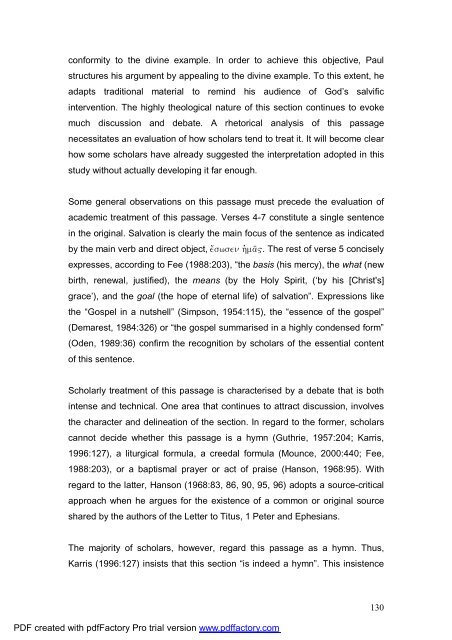A Text centred rhetorical analysis of Paul's Letter to Titus
A Text centred rhetorical analysis of Paul's Letter to Titus
A Text centred rhetorical analysis of Paul's Letter to Titus
You also want an ePaper? Increase the reach of your titles
YUMPU automatically turns print PDFs into web optimized ePapers that Google loves.
conformity <strong>to</strong> the divine example. In order <strong>to</strong> achieve this objective, Paul<br />
structures his argument by appealing <strong>to</strong> the divine example. To this extent, he<br />
adapts traditional material <strong>to</strong> remind his audience <strong>of</strong> God’s salvific<br />
intervention. The highly theological nature <strong>of</strong> this section continues <strong>to</strong> evoke<br />
much discussion and debate. A <strong>rhe<strong>to</strong>rical</strong> <strong>analysis</strong> <strong>of</strong> this passage<br />
necessitates an evaluation <strong>of</strong> how scholars tend <strong>to</strong> treat it. It will become clear<br />
how some scholars have already suggested the interpretation adopted in this<br />
study without actually developing it far enough.<br />
Some general observations on this passage must precede the evaluation <strong>of</strong><br />
academic treatment <strong>of</strong> this passage. Verses 4-7 constitute a single sentence<br />
in the original. Salvation is clearly the main focus <strong>of</strong> the sentence as indicated<br />
by the main verb and direct object, e[swsen hJma`". The rest <strong>of</strong> verse 5 concisely<br />
expresses, according <strong>to</strong> Fee (1988:203), “the basis (his mercy), the what (new<br />
birth, renewal, justified), the means (by the Holy Spirit, (‘by his [Christ's]<br />
grace’), and the goal (the hope <strong>of</strong> eternal life) <strong>of</strong> salvation”. Expressions like<br />
the “Gospel in a nutshell” (Simpson, 1954:115), the “essence <strong>of</strong> the gospel”<br />
(Demarest, 1984:326) or “the gospel summarised in a highly condensed form”<br />
(Oden, 1989:36) confirm the recognition by scholars <strong>of</strong> the essential content<br />
<strong>of</strong> this sentence.<br />
Scholarly treatment <strong>of</strong> this passage is characterised by a debate that is both<br />
intense and technical. One area that continues <strong>to</strong> attract discussion, involves<br />
the character and delineation <strong>of</strong> the section. In regard <strong>to</strong> the former, scholars<br />
cannot decide whether this passage is a hymn (Guthrie, 1957:204; Karris,<br />
1996:127), a liturgical formula, a creedal formula (Mounce, 2000:440; Fee,<br />
1988:203), or a baptismal prayer or act <strong>of</strong> praise (Hanson, 1968:95). With<br />
regard <strong>to</strong> the latter, Hanson (1968:83, 86, 90, 95, 96) adopts a source-critical<br />
approach when he argues for the existence <strong>of</strong> a common or original source<br />
shared by the authors <strong>of</strong> the <strong>Letter</strong> <strong>to</strong> <strong>Titus</strong>, 1 Peter and Ephesians.<br />
The majority <strong>of</strong> scholars, however, regard this passage as a hymn. Thus,<br />
Karris (1996:127) insists that this section “is indeed a hymn”. This insistence<br />
PDF created with pdfFac<strong>to</strong>ry Pro trial version www.pdffac<strong>to</strong>ry.com<br />
130

















